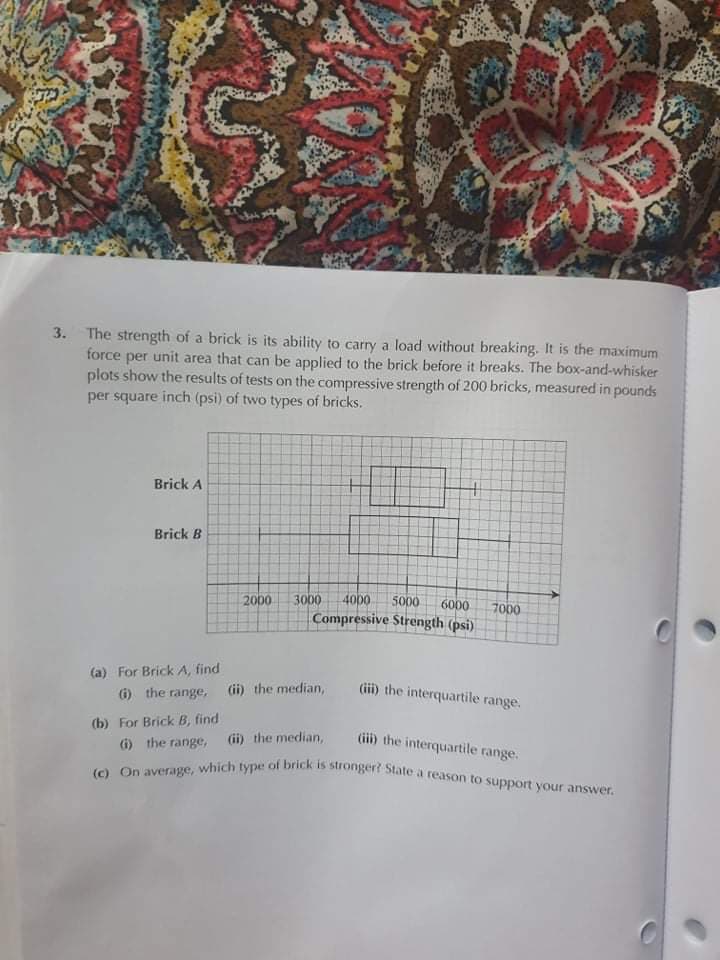(c) On average, which type of brick is stronger? State a reason to support your answer. 3. The strength of a brick is its ability to carry a load without breaking. It is the maximum force per unit area that can be applied to the brick before it breaks. The box-and-whisker plots show the results of tests on the compressive strength of 200 bricks, measured in pounds per square inch (psi) of two types of bricks. Brick A Brick B 200 3000 4000 5000 6000 7000 Compressive Strength (psi) (a) For Brick A, find 6) the range, (ii) the median, (iii) the interquartile range. (b) For Brick B, find (i) the range, (ii) the median, (ii) the interquartile range. is
(c) On average, which type of brick is stronger? State a reason to support your answer. 3. The strength of a brick is its ability to carry a load without breaking. It is the maximum force per unit area that can be applied to the brick before it breaks. The box-and-whisker plots show the results of tests on the compressive strength of 200 bricks, measured in pounds per square inch (psi) of two types of bricks. Brick A Brick B 200 3000 4000 5000 6000 7000 Compressive Strength (psi) (a) For Brick A, find 6) the range, (ii) the median, (iii) the interquartile range. (b) For Brick B, find (i) the range, (ii) the median, (ii) the interquartile range. is
Mathematics For Machine Technology
8th Edition
ISBN:9781337798310
Author:Peterson, John.
Publisher:Peterson, John.
Chapter65: Achievement Review—section Six
Section: Chapter Questions
Problem 44AR: Solve these prism and cylinder exercises. Where necessary, round the answers to 2 decimal places...
Related questions
Question
4c #3

Transcribed Image Text:(c) On average, which type of brick is stronger? State a reason to support your answer.
3. The strength of a brick is its ability to carry a load without breaking. It is the maximum
force
unit area that can be applied to the brick before it breaks. The box-and-whisker
per
plots show the results of tests on the compressive strength of 200 bricks, measured in pounds
per square inch (psi) of two types of bricks.
Brick A
Brick B
4000
5000
Compressive Strength (psi)
2000
3000
6000
7000
(a) For Brick A, find
(ii) the median,
(ii) the interquartile range.
(6) the range,
(b) For Brick B, find
(i) the range,
(ii) the median,
(ii) the interquartile range.
Expert Solution
This question has been solved!
Explore an expertly crafted, step-by-step solution for a thorough understanding of key concepts.
Step by step
Solved in 5 steps with 1 images

Recommended textbooks for you

Mathematics For Machine Technology
Advanced Math
ISBN:
9781337798310
Author:
Peterson, John.
Publisher:
Cengage Learning,

Functions and Change: A Modeling Approach to Coll…
Algebra
ISBN:
9781337111348
Author:
Bruce Crauder, Benny Evans, Alan Noell
Publisher:
Cengage Learning


Mathematics For Machine Technology
Advanced Math
ISBN:
9781337798310
Author:
Peterson, John.
Publisher:
Cengage Learning,

Functions and Change: A Modeling Approach to Coll…
Algebra
ISBN:
9781337111348
Author:
Bruce Crauder, Benny Evans, Alan Noell
Publisher:
Cengage Learning
